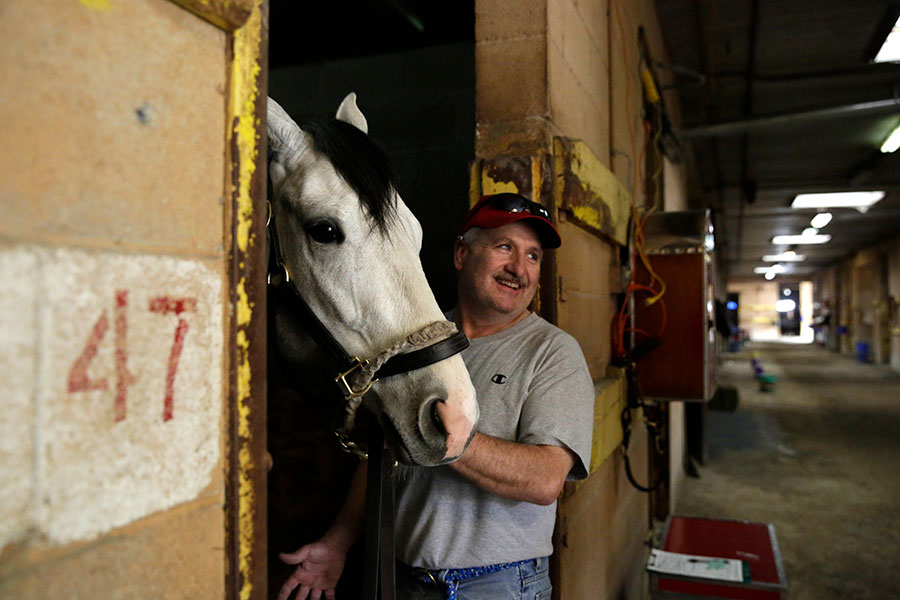Unlike Arlington Park, its bucolic former counterpart, Hawthorne Racecourse has never been a lovely place to watch a horse race. Known to horseplayers as The Thorne, the track is located in southwest suburban Stickney, between Cicero and Laramie avenues, offering a vista of oil refineries and the world’s largest sewage treatment plant. Today, the experience is even grottier. The grandstand has been torn away, and disgruntled gamblers are crowded into a single room near the finish line, with a concession stand selling pizza, tacos, and hot dogs. The track only runs Thoroughbreds two days a week, on Thursdays and Sundays, and many of the races include but six horses, the bare minimum for profitable wagering.
It wasn’t always this way. Twenty years ago, I published a book about gamblers titled Horseplayers: Life at the Track. Back then, Hawthorne ran five days a week, with 12-horse fields that guaranteed long odds on the winners. Every spring, the track ran the Illinois Derby, whose champion was almost guaranteed to run in the Kentucky Derby. The Sun-Times had a horse racing columnist. The Tribune published picks. Race replays aired on TV. Those were the days. So what happened to racing in Chicago?
Once upon a time, horse racing had a monopoly on legal gambling. Beginning in the 1970s, that was gradually eroded — first with lotteries, then riverboat gambling, and now sports betting. In many states, including Indiana, Ohio, Pennsylvania, Kentucky, and New York, race tracks have remained open by becoming racinos: combination race tracks and casinos where money from gambling funds purses for racing. In 2019, the Illinois General Assembly passed a law allowing the state’s racetracks to open casinos. Arlington Park was owned by Churchill Downs, which already owned Rivers Casino in Des Plaines, so the company decided to tear the track down rather than build a competing racino. As the last track standing in the Chicago area, Hawthorne was the only spot left for a racino. But six years later, the track hasn’t managed to get it built, despite tearing up its grandstand to make room for slots, blackjack, and roulette.
“We’re in dire straits here, but there is a remedy, and the remedy is a racino,” says David McCaffrey, executive director of the Illinois Thoroughbred Horsemen’s Association. “Each year that goes by, I’m less inclined to think that’s going to happen under the Hawthorne banner.”
Look at the numbers. In 2004, the total handle — or money bet — on racing in Illinois was $1.06 billion. Last year, it was $477 million. In 2022, there were 908 horses stabled at Hawthorne. This year, 550. The Illinois breeding industry is almost extinct, from 1,200 foals in 2005 to 108 foals in 2025. The reason, says veteran trainer Chris Block, is that horsemen are now running their stock at out-of-state tracks that offer bigger purses. Tracks with casinos.
“It’s not making sense for me to continue running in Illinois,” says Block, who would like to stay in his home state, but is no longer finding it profitable. “I ran out of town more than I ever have this year. I made multiple starts in Indiana and Kentucky.”
A representative from Hawthorne did not return a phone call asking for a comment on the racino’s progress. But in September, racetrack president Tim Carey told the Illinois Racing Board that…they’re working on it, but they’re having trouble securing financing for the $400 million project.
“I can tell you that we came in here last year with the hope of announcing our project,” Carey said. “We had an internal issue that we weren’t able to overcome with our investor. We unfortunately had to go back out to the market. We have done that. We’re committed to doing this project. We are in a very, very good position again this year. We anticipate that we’ll be able to make an announcement sometime in the fourth quarter in terms of where we are with the project. We anticipate that if we announce in the fourth quarter, we would be open by the fourth quarter of 2027.”
The fourth quarter is here, and there has been no announcement. The racing industry argues that since the state took away its monopoly, it deserves a share of the new wagering. On the other side of that argument are animal rights advocates who say states shouldn’t use casino gambling to prop up a dying sport.
“I think they should be left to their own devices,” says Kathy Guillermo, senior vice president of the People for the Ethical Treatment of Animals. “If they can find a way to increase interest, that’s up to them.”
In the 1940s, horse racing was one of the Big Three sports, along with boxing and baseball. Hawthorne displays historical photos from that era of the apron crowded with thousands of racing fans. Guillermo believes one reason for the sport’s loss of popularity is that “people see it as cruel now. Certainly, it would shrink without support of racinos, and there would be fewer horses subjected to this.”
Hawthorne may be one of those casualties, if it can’t secure financing for a casino.
“If it doesn’t happen,” predicts McCaffrey, “racing will cease to exist in Chicago within the next year.”



